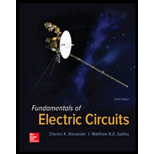
The crossover circuit in Fig. 14.108 is a low-pass filter that is connected to a woofer. Find the transfer function H(ω) = Vo(ω)/Vi(ω).
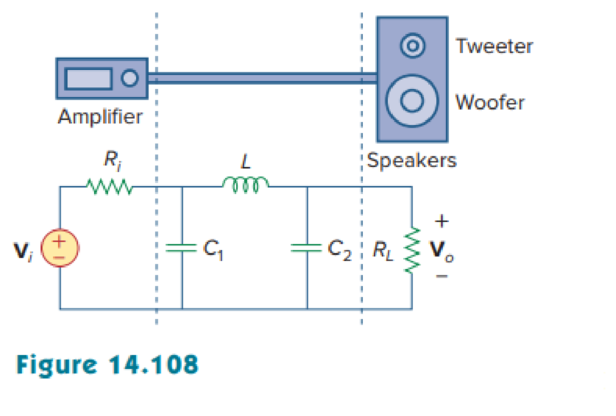
Find the transfer function
Answer to Problem 96P
The transfer function
Explanation of Solution
Given data:
Refer to Figure 14.108 in the textbook.
Formula used:
Write a general expression to calculate the impedance of resistor in s-domain.
Here,
Write a general expression to calculate the impedance of an inductor in s-domain.
Here,
Write a general expression to calculate the impedance of a capacitor in s-domain.
Here,
Write the general expression to calculate the transfer function of the system
Here,
Calculation:
The given circuit is redrawn as Figure 1.

The s-domain circuit of the Figure 1 is drawn as Figure 2 using the equations (1), (2), and (3).
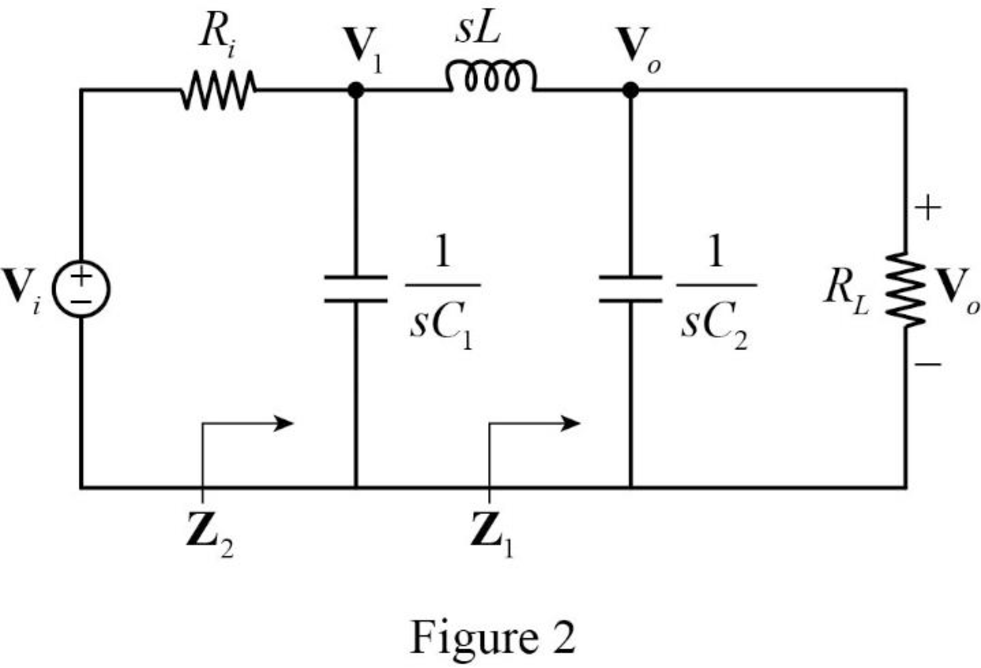
Refer to Figure 2, the resistor
The Figure 2 is redrawn as Figure 3.
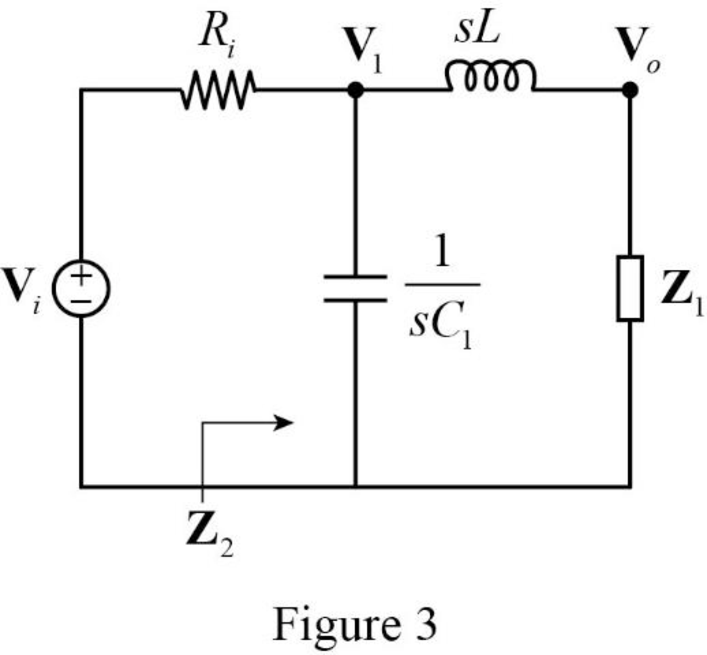
Refer to Figure 3, the inductor
Substitute
Simplify the above equation to find
The Figure 3 is redrawn as Figure 4.
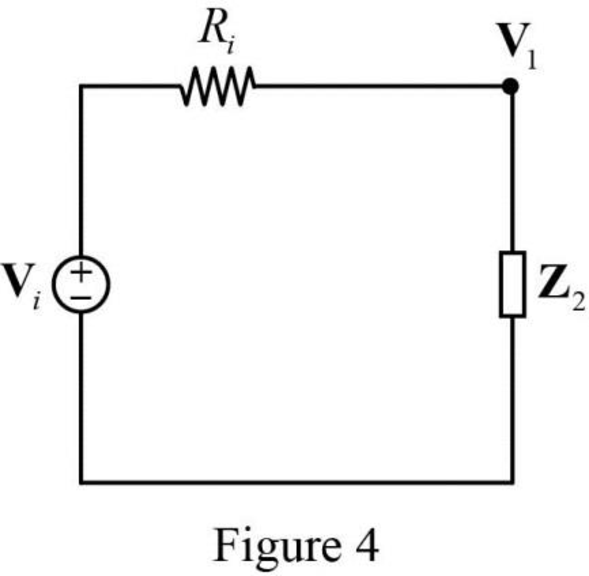
Apply voltage division rule on Figure 4 to find
Apply voltage division rule on Figure 3 to find
Substitute
Rearrange the above equation to find
Substitute
Simplify the above equation to find
Substitute
From the equation (5), the equation (4) becomes,
Conclusion:
Thus, the transfer function
Want to see more full solutions like this?
Chapter 14 Solutions
Fundamentals of Electric Circuits
- 746. (NEW) Some linear system has a transfer function 9(s+2)/(s+4). Determine the Bode plot gain (dB) and phase at 9.00 rad/sec.arrow_forwardI tried graphing this transfer function to matlab, are my inputs correct? (bode plot)arrow_forwardHi, can you please draw a stright line bode aproximation for the transfer function in the attached picture. On the graph include individual componentsarrow_forward
- On the circuit below, assume all initial conditions are 0 and that R = 1kΩ, L = 1mH, and C = 1uF. Problem: Sketch by hand the bode plots of the system. Clearly explain your reasoning. Needs Complete solution with 100 % accuracy.arrow_forwardUse the following values for the evaluation of the transfer function: R = 10Ω, C1= 1 μF, C2= 2.2 μF. Build the Bode plot. and simulate the bode plot in MATLAB.arrow_forwardGiven the circuit below: Find the transfer function with respect to the frequency, w. That is, what is H(w) = Vo(w)/Vin(w).arrow_forward
- Draw the Bode Diagram for the system given the transfer function below. Use the Bode diagram to interpret the stability of the system. ( I would appreciate it if you could help quickly :) )arrow_forwardG(S) =100(s+10)/s(s+5)(s+20) 3. Construct the bode Plot of the system using the semilog paper provided.4. Determine the Gain margin and phase margin of G(jw)5. Using the Bode diagram determine if system is stable.arrow_forwardMake bode plots of these transfer functions. Do not answer in image formatarrow_forward
- Find the transfer function Vo/Vs of the circuit in Fig. 14.86. Show that the circuit is a low-pass filter.arrow_forward1) from rootlocus fig , Determine damping ratio and ( Wn ) of the closed loop system for K=10.2) Sketch the approximate graph of the Bode magnitude of the transfer function (use K=100). please answer me part 1 and 2arrow_forwardA coil of inductance 0.20H and resistance 60[1] is connected in parallel with a 20μF capacitor across a 20V, variable frequency supply. Calculate (a) the resonant frequency, (b) the dynamic resistance, (c) the current at resonance and (d) the circuit Q-factor at resonance.arrow_forward
 Introductory Circuit Analysis (13th Edition)Electrical EngineeringISBN:9780133923605Author:Robert L. BoylestadPublisher:PEARSON
Introductory Circuit Analysis (13th Edition)Electrical EngineeringISBN:9780133923605Author:Robert L. BoylestadPublisher:PEARSON Delmar's Standard Textbook Of ElectricityElectrical EngineeringISBN:9781337900348Author:Stephen L. HermanPublisher:Cengage Learning
Delmar's Standard Textbook Of ElectricityElectrical EngineeringISBN:9781337900348Author:Stephen L. HermanPublisher:Cengage Learning Programmable Logic ControllersElectrical EngineeringISBN:9780073373843Author:Frank D. PetruzellaPublisher:McGraw-Hill Education
Programmable Logic ControllersElectrical EngineeringISBN:9780073373843Author:Frank D. PetruzellaPublisher:McGraw-Hill Education Fundamentals of Electric CircuitsElectrical EngineeringISBN:9780078028229Author:Charles K Alexander, Matthew SadikuPublisher:McGraw-Hill Education
Fundamentals of Electric CircuitsElectrical EngineeringISBN:9780078028229Author:Charles K Alexander, Matthew SadikuPublisher:McGraw-Hill Education Electric Circuits. (11th Edition)Electrical EngineeringISBN:9780134746968Author:James W. Nilsson, Susan RiedelPublisher:PEARSON
Electric Circuits. (11th Edition)Electrical EngineeringISBN:9780134746968Author:James W. Nilsson, Susan RiedelPublisher:PEARSON Engineering ElectromagneticsElectrical EngineeringISBN:9780078028151Author:Hayt, William H. (william Hart), Jr, BUCK, John A.Publisher:Mcgraw-hill Education,
Engineering ElectromagneticsElectrical EngineeringISBN:9780078028151Author:Hayt, William H. (william Hart), Jr, BUCK, John A.Publisher:Mcgraw-hill Education,





